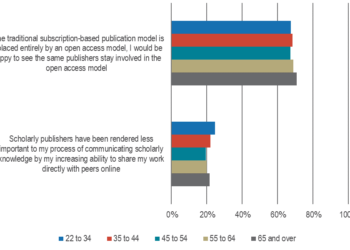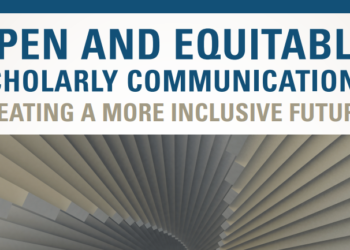Editor’s Note: Today’s post is by Shaun Khoo. Shaun is a postdoctoral fellow at the Université de Montréal where he studies the neuroscience of addiction. He is the founder of Episteme Health Inc., non-profit association that aims to provide free open access neuroscience publishing.
A goal of open access is a reduction in barriers to knowledge for no additional cost. In fact, the Budapest Open Access Initiative envisioned an open access world could be achieved at lower cost than traditional publishing. More recently, the University of California’s Pay it Forward project relies on the idea that authors will exercise their market power to put downward pressure on article processing charges (APCs). But as a scientist, my evaluation criteria are predominately centered around ‘more papers in higher ranking journals’. I am doubtful that authors have ever had much market power and, to the extent that we do, I have no expectation we will be using it to push down fees.

Please take my copyright
Under traditional subscription publishing, authors would assign their copyrights to publishers for free or even pay for the privilege of doing so. Surveys of academics have found the majority of authors believe that copyright should be retained by authors. But when it comes time to sign a copyright transfer agreement, almost everyone signs even though around half are reluctant to do so. Only around 2% of authors try to modify the terms of copyright agreements. Given there is a significant risk that negotiating around copyright could delay or prevent publication, it’s not surprising that authors are not willing to play copyright hardball with their careers.
In the open access world, it is still the case that many authors are not getting what they want with copyright. Around a third of authors would prefer to restrict commercial use of their work. Yet, large open access publishers like BMC and Frontiers will only publish works under a Creative Commons Attribution license that permits commercial use. While this might please Plan S funders, it means that even when authors are paying customers, they do not have the leverage to change the terms of their publishing agreements.
Do authors have power over price?
There is no reason why authors who can pay an APC will choose cheaper journals. University of California librarian Jeffrey MacKie-Mason argues that in an APC-gold open access world, authors will be incentivized to consider the APC when considering journals for their papers. It is true that open access has added a lot of price variability into publishing, but it has also added complexity and increased risks for authors, enhancing the market power of publishers.
The current publishing landscape is a fragmented patchwork of institutional and funder open access mandates, with journals promoting green, gold and diamond/platinum open access. Authors now need to know the difference between a preprint, post-print, and a version of record, and have a working knowledge of publisher embargoes, copyright, and creative commons licensing. The information asymmetry between authors and publishers means that authors can’t realistically assess whether an APC is reasonable or not.
In some respects, a higher APC represents a form of insurance. The rise of predatory publishers charging low fees, has increased the risks for authors. If a librarian subscribes to a bad journal, they can just cancel it, but a manuscript represents months, or possibly years of effort. Paying a few thousand dollars from research funds to avoid having it held hostage is a bargain.
To the extent that authors have the power of choice in the scholarly publishing market, we are not using it to drive down APCs. In a recent study, I found no evidence that journals that increase or introduce an APC lose business in terms of article volume. In fact, tracking APCs at major commercial publishers from 2012-2018 showed that higher APCs tended to predict higher article volumes – consistent with how the majority of open access papers are published in a minority of fee-charging journals.
To the extent that authors have an incentive to try and save money on APCs, it is probably trivial when compared with the imperative to publish more papers in higher ranking journals. No librarian is ever going to care more about my career than I do, so while a librarian might balk at a $3,000 subscription to the Journal of Neuroscience, I would happily spend $6,000 in research funds to put an elite journal title on my CV. As publishers are happy to point out, publishing costs are around 1% of research expenditure, so it doesn’t make much difference to a project’s overall costs if we take the more expensive option.
Succeed alone where consortia have failed
If an $11 million customer like the University of California or consortia representing Germany and Sweden cannot get a satisfactory deal from Elsevier, it doesn’t seem likely that authors will be keeping APCs in check. APCs are already rising faster than inflation when fully open access journals make up around 15-20% of the market for journals or articles, so imagine what could happen if demand was increased further by Plan S-style mandates. Having authors pay APCs doesn’t change our evaluation criteria, the value of joining an exclusive club by publishing in a particular journal, or force publishers to compete on price. Instead, authors are competing to publish more papers in higher ranked and more expensive journals, just like we always have.
Discussion
15 Thoughts on "Guest Post: Do Authors Have Any Power Over Publishers?"
a sad reality for the academic publishing industry
At last an honest look at the environment in which scholars publish. What seems most honest is the implication that author’s really don’t care that much about readership as much as they do about their careers which are closely tied to the prestige of the journal which publishes their article. Thus, reputation still counts! However, it is implied that authors do care about others exploiting their work. Thus, the copyright maintains a place in their considerations.
Readership and prestige are closely tied together. A prestigious journal gets read by the top people in the field. When we think about where to submit, we generally aim for the highest ranking journal that serves our desired audience.
Since academia is primarily a not-for-profit space I think a lot of academics are inclined towards non-commercial licensing, but it’s always not high on the priority list. I tend not to bother with the NC condition – not many people can compete with ‘free’ – but I think authors should have a choice. It’s not hard to link to CC BY-NC instead of CC BY.
This might be extreme, but what if educational institutions changed the schematics of career development? This takes pressure off authors to sell their rights. This will never happen of course but a lot is written about the decisions authors make; I rarely see anyone talking about research institutions’ role in endorsing this ugly relationship between readership and prestige.
Indeed, article processing charges may be a Veblen good.
This posting is a very important contribution in spurring reflection about the microeconomics of researcher/author preferences.
I’ve long thought that APCs would replicate the inelasticities obvious in the toll-access subscription markets.
The points in this posting relate to another observation, namely that one can safely assume, in modeling the economics of publishing, that it is very difficult to make any assumptions that any particular actor will change their behaviors unless significantly incentivized. This is of course not an indictment of the many agents and constituencies within the publishing ecosystem. It’s just how economic systems operate, and reflects preferences that in turn merely reflect human nature. Why should we expect researchers to shop around for APC deals? It’s not reasonable for them to do so.
I’d personally like to see libraries do a coordinated contraction of the journals space, in line with something like Bradford’s Law (not necessarily tied to the specific methodology used to justify it), and with an emphasis on articles as critical reviews of things going on in the preprint space, but this goal itself is beholden to changing a whole complexus of erstwhile practices. In this case, major universities at least have so many employees on the editorial boards etc. of journals that this would be very difficult to accomplish. Not to mention the role t and p standards play. So I’m not optimistic that any reforms of these kinds will emerge.
Maybe the market will sort things out, under the pressure of library budgetary constraints. That’s my bet.
Re. whether APC charges will spiral upward year over year depends on how willing funding agencies are to support their payment. I personally don’t think it’s a good use of taxpayer money that can be devoted to other purposes.
In the meantime, we should not be so pessimistic as to think there cannot be a number of small, incremental changes and efforts worth pursuing, but that is a big story.
Finally a realistic view of the scholarly publishing world from an scientific author and researcher. Most of the views we hear are from librarians talking about the high cost of journals and they often have little understanding of the publishing business practices. Asking an author to negotiate a special deal with a large for profit publisher is near impossible. Take into consideration the average manuscript rejection rate is over 80%, publishers have an abundance of authors manuscripts ready to publish. Publishing in a high impact journal is still a cherished goal of a young researcher.
To be fair, I am also complaining about the high cost of journals! But you’re absolutely right – Elsevier/Springer/Wiley won’t notice if my article doesn’t get up in their journal. However, the committee that considers my fellowship/grant application will be basing a huge part of their decision on my publication record.
Are you sure that ‘the average manuscript rejection rate is over 80%’? Perhaps the most selective journals reject >80% of submissions, but there are many journals which reject a far lower proportion of submissions, and of course there are many journals which publish most submissions they receive.
I should have qualified my response regarding rejection rates to the top 20 STM publishers. I have audited and worked closely with many publishers in this group and most of the publishers are drowning in manuscripts. Rejection rates for the high impact journals is actually higher than 80 %. You are correct that there are many publishers where few manuscripts are rejected. Tenure and promotion committees are aware of the landscape.
It seems that the underlying problem is the APC model for subsidizing publications…which puts the pressure on the author. Maintaining an organizational support model with some type of subscription will continue to include the long-tail dollars from non-producers that are a significant part of the traditional economic model. Such a subscription model will continue to obtain funding from the readers who benefit from the materials (corporations, small universities, etc.). Of course, we can always use new technologies (OER possibilities) to provide alternatives if the commercial publishers refuse to reduce their costs to a reasonable and sustainable level.
It is possible to make a deal with the publisher but retain a copyright on the material to use in future publications with different publishers:.the ownership is retained by the person who produced the intellectual property to use in a a future textbook etc.
Many publishers leave copyright with the author and instead ask them to sign a license to publish the article. These are often “exclusive” licenses, but they also carve out a large number of exceptions, usually things like the reuse of the materials for a thesis or teaching or subsequent articles or book chapters by the authors.
Hi, I’m happy to be disabused by evidence au contraire, but I don’t think researcher perception of publisher flexibility in allowing tweaking of author rights (e.g., a la the Sparc addendum) when deciding whether to publish in journal A versus journal B will accomplish the enhanced market power that the U Cal claims appear to presume wrt to APCs. I.e., I doubt whether publisher flexibiliity in responding to requests by researchers to tweak a license will significantly affect researcher decision to publish in A versus B, in the aggregate.
It is indeed possible, if the publisher agrees with it. It’s a negotiation.



